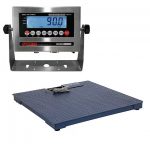If you’re like most businesses, you need your scales and weighing equipment to work correctly every single day. But if you own floor scales then you probably know that not every forklift driver is going to gently place the pallet on top of the pallet scale. Often a pallet is placed on top of the floor scale in what some would call a “mix of dropping or quickly placing” the weight amount on the top of the platform. We often refer to it as shock loading. Floor scales do not like shock loading. Better yet… strain gauge load cells also do not like shock loading. It can be a fine line with some forklift drivers. In the metal recycling business they need to be quick but there has to be a certain amount of finesse too.
So today I’d like to talk a little more about dropping pallets on top of a floor scale and what can happen when your forklift driver literally drops the pallet on the scale. I’ve even seen scale manuals over the years that say drop the pallet on the scale. Of course, they mean to gently set the pallet on the scale. Anyway, hopefully from today’s entry we can show you some of the problems to think about and maybe even help you better educate your employees about the risks and increased costs when shock loading occurs.
What Does Shock Loading a Floor Scale Mean?
Shock loading can occur with many different types of scales but we see it most often with 4×4 and 5×5 size pallet scales which are also known as floor scales or platform scales. The term shock loading itself basically refers to dropping a large amount of weight onto the scale at one time. It usually happens fast and with a lot of force. It can sometimes even damage or bend the scale deckplate and/or the scale platform itself. It usually wipes out a load cell or two as well.
Now you might be wondering about the amount of weight dropped versus the total capacity of the scale. For example, you may have only dropped a thousand pounds on the scale. And, you have a five thousand pound capacity. So you shouldn’t have any issues, right?
I’m no engineer and I can only get so technical…. but basically it’s about the force and shock. You might be under the max capacity of the scale but when you drop that amount and with that force, the scale and the cells are very susceptible to breaking. And there’s also the height of the drop to consider as well.
Scale Damage from Shock Loading Now & in the Future
When something gets dropped onto a scrapyard platform scale, it can lead to immediate failure. Or, it might simply lead to a scale that now has a shifted load cell. In other words, the scale is still working but one of the load cells has shifted out of tolerance. So you might still be weighing but you now have one of your four load cells that needs to be replaced. Even the best of load cell brands can’t handle shock loading. If you’re lucky, all the cells might still be ok and you just need a zero calibration and a span calibration.
Permanently damaging load cells is one of the common issues with shockloading. Another problem that we sometimes see is damage to the scale platform itself which we mentioned earlier. The damage might be just the top plate or if the weight was forceful enough, the entire platform could be damaged. It’s important to train forklift drivers about how a scale is a precise instrument that needs a certain amount of precision loading and unloading because if shockloading or near shock-loading keeps happening this may cause long-term damage to your floor scale that ultimately reduces the scale’s overall lifespan.

So What Can I Do to Stop Shock Loading My Scales?
One thing to consider is investing in a high quality floor scale like the Rice Lake Roughdeck or B-Tek Clydesdale. These are truly “industrial heavy duty” versus the lightweight import scales that you see everywhere. These decks can be shock loaded and overloaded too but they are physically better built and might be a solution for certain situations.
However, the best way to prevent shock loading is usually accomplished by training your forklift drivers or whomever is loading your scales on a daily basis. Many times your drivers may be good and safe 99% of the time. But often a driver gets in a hurry for whatever reason and next thing you know, the scale is not weighing right. Or maybe they got distracted for some reason…. And in most companies once you start asking questions like how did this happen? Nobody seems to know the answer.
One good way to handle this is to have an honest talk with your employees about the dollars and cents. When your business is running smoothly, you’re producing X number of dollars per hour. But when the scale is down all of that becomes 0 dollars per hour. Plus we’re having to pay a scale company $400 for a service trip to troubleshoot a scale and $200 for a new load cell as an example. Training and honest discussions can make a big difference. A video camera system can also make a big difference as well. Scale gets broken, let’s go to the video tape!